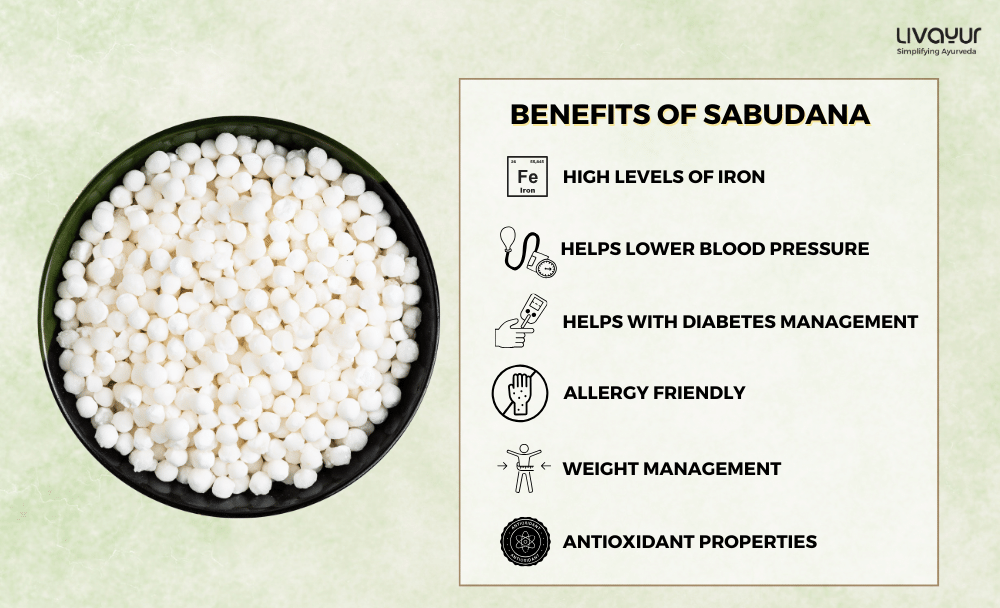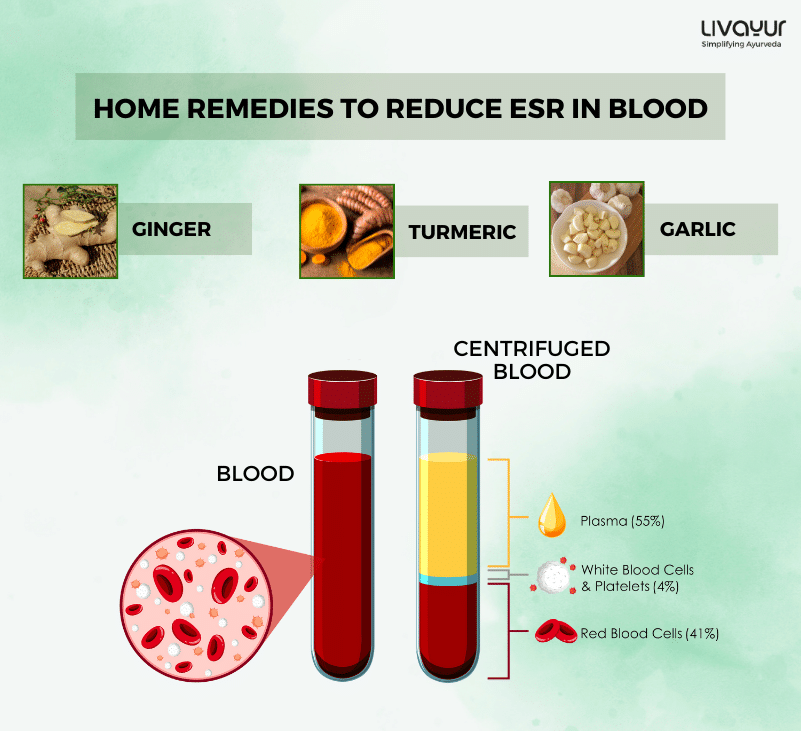
Have you ever been enticed by those milky white sabudana pearls? In India, sabudana is widely used for its many therapeutic purposes. Sabudana is also known as sago. It is a starchy substance extracted from the pith of sago palm stems. It is a popular food ingredient in Indian cuisine and is usually used to make dishes like sabudana khichdi, vada, and kheer. Sabudana is a versatile ingredient used in sweet and savoury dishes, making it a staple in many Indian households. Sabudana has gained recognition as a nutritious food source worldwide in recent years. Ayurveda mentions numerous benefits of eating sabudana. In this article, we’ll explore the various sabudana benefits, sabudana nutrition facts, sabudana side effects, and more. Read on:
Nutritional profile of sabudana
The impressive health benefits of sabudana can be attributed to sabudana’s nutritional value. While it primarily consists of carbohydrates, it also contains essential minerals and vitamins, including iron, calcium, manganese, and thiamine. These nutrients in sabudana play a vital role in supporting various bodily functions. The table below shows nutritional value of sabudana:
| Nutrients | Value |
| Calories | 350 Kcal |
| Fat | 0.2 gram |
| Dietary Fiber | 0.5 gram |
| Carbohydrates | 85.5 gram |
| Protein | 0.2 gram |
| Potassium | 5 mg |
| Iron | 1,3 mg |
| Phosphorus | 10 mg |
| Sodium | 3 mg |
| Calcium | 10 mg |
Sabudana properties
The immense sago benefits make it a potential option for managing overall health. The following are some of the most prominent properties of sabudana.
- Cooling or sheetal in nature
- Easily digestible
- Instant energy-booster
- Gluten-free
- Calorie-dense
- Starchy
- Calms the Vata Dosha
Sabudana health benefits
Let us explore the various health benefits of sabudana:
1. Offers antioxidant protection
Antioxidants are molecules that come with free radicals-scavenging properties. When free radical levels become too high in the body, they may lead to cellular damage, which is linked to health issues like cancer and heart disease. Ayurveda also lists the benefits of sabudana for skin. Applying sabudana face pack aids in providing relief from acne and pimples. Sabudana contains antioxidants such as phenolic compounds and flavonoids, which can offer protection to your body against oxidative stress. [1]
2. Is fibre-rich
Sabudana has long been recognized for its positive effects on digestive health. Due to its high fibre content, sabudana helps in supporting regular bowel movements and preventing constipation. The ample presence of fibre contributes to the gradual release of energy, enabling individuals to feel fuller for longer time periods and reducing the likelihood of overeating.
3. Helps in weight management
Sabudana for weight loss works in a number of ways. Incorporating sabudana into a balanced diet can also promote effective weight management. Its slow-release energy properties make it ideal for sustaining energy levels throughout the day.
The high fibre content and low-fat composition of sabudana further contribute to feelings of fullness, reducing the temptation to indulge in calorie-dense snacks.
Moreover, sabudana’s natural sugars are gradually absorbed into the bloodstream, preventing sudden blood sugar spikes and providing a steady source of energy. These factors collectively contribute to a healthier and more sustainable approach to weight management.
4. Supports gut health
One of the many benefits of eating sabudana is its positive impact on gut health. Sabudana’s gentle effect on the digestive system makes it an excellent option for those suffering from mild gastrointestinal disorders or sensitivity to certain foods. Sabudana is approximately 7.5% resistant starch, a kind of starch that moves through the digestive tract without being broken down by enzymes. Resistant starch acts as a prebiotic, which means it feeds the useful bacteria in the gut and could relieve common digestive problems.
5. May help diabetics
Although more research is needed, it is generally thought that certain types of resistant starch can help with the management of prediabetes or diabetes. Research indicates that sabudana may reduce insulin resistance, making blood sugar easier to control. [2]
6. Keeps heart healthy
Sabudana may have some beneficial effects on heart health by causing a drop in your blood pressure and cholesterol levels. One study found that sago pearls reduced systolic blood pressure and total cholesterol in rats with high blood pressure [3]. Sabudana is also believed to help lower triglyceride levels and increase HDL (good) cholesterol levels. These effects may be due to the presence of dietary fibre and antioxidants in sago.
7. Improves physical and mental performance
Sabudana may also be a good option for sportspeople and active individuals who need a quick energy source. Sabudana has a high glycemic index (GI), which means it raises blood sugar levels rapidly after consumption. This can provide a burst of glucose to the muscles and brain, enhancing physical and mental performance. One study showed that sabudana porridge improved endurance capacity and reduced fatigue in cyclists compared to rice porridge, demonstrating sabudana benefits for males and females alike.. [4]
8. Promotes musculoskeletal health
The high levels of iron found in sabudana can help prevent anaemia, while calcium and manganese present in sabudana contribute to developing and maintaining b bones and teeth. At the same time, thiamine in sabudana is important for healthy muscle contraction.
9. Ideal for Women’s Health
Sabudana’s benefits for females are immense. Sabudana, rich in iron and calcium, is ideal for enhancing milk production and balancing hormonal activities in expectant women and young mothers.
Sabudana Side Effects & Safety
- High Glycaemic Index: Sabudana has a high glycaemic index, meaning it can lead to rapid increase in blood sugar levels. This means that despite its benefits for reducing insulin resistance, individuals with diabetes should use sabudana with caution.
- Calorie Content: Although it can increase satiety because of its fibre content, sabudana is also calorie-dense. So, although it can help with weight loss when balanced with nutritious foods, it can also aggravate weight gain when eaten in excess.
- Digestive Issues: Some people may experience digestive problems like bloating, gas, or constipation when consuming sabudana if it is not soaked and cooked properly.
- Allergies: In very rare cases, individuals may be allergic to sabudana. If you have a known allergy to tapioca it would be best to avoid sabudana.
How to use sabudana?
Apart from being used mainly for sabudana health benefits, sabudana may be used for several other reasons, such as:
1. As a ‘Vrat’ food
Sabudana is a typical Vrat food in India. It has a religious and traditional value in Indian culture. People who fast during pujas and holy ceremonies usually prepare various delicacies out of sabudana, an appropriate food item for fasting due to its high carbohydrate content. [6]
2. As a food for the sick
Sabudana can be given to sick people, especially the ones with loose motion and other stomach disorders, as it supplies energy to the body and is highly digestible. In such cases, patients are given sabudana gruel.
3. As a baby food
Sabudana is an excellent baby food. It may be given to babies below the age of 1 year and even beyond the age of 1 year. It is the perfect weaning baby food to support weight gain of your little one, and is definitely a wholesome food choice simply ideal for your baby’s ever-expanding nutritional needs. [5]
4. As a food for lactating mothers
Sabudana soaked in water may be given to lactating mothers for adequate milk production.
5. As a natural sleep inducer
Sabudana may even act as a sleep inducer. Taking sabudana soaked in milk at bedtime not only improves your sleep quality but also your sexual stamina.
6. As a beauty-enhancer
Sabudana comes with beauty benefits as well. The phenolic compounds and tannins in sabudana can help your skin in several ways. Applying a sabudana face pack can help you fight against sun tan, dry skin issues, skin aging, etc. Even the sabudana hair mask is good for your hair. Amino acids in sabudana promote hair growth; their antimicrobial properties help fight dandruff.
Here are some quick tips on using sabudana
- You may use sabudana by soaking it in water overnight and consuming it along with the water the next day.
- You may also boil sabudana pearls in some milk and drink the milk along with the sabudana pearls.
- Furthermore, you may use sabudana to prepare several super-tasty, filling delicacies that are great for your health and palate.
Some amazing sabudana recipes
Sabudana Kheer
This is a delicious and luscious Indian dessert prepared by cooking sabudana pearls in milk with sugar, cardamom powder, and saffron strands.
Sabudana Khichdi
This is a light khichdi recipe made from sabudana. You may use spices like jeera, curry leaves, grated ginger, bay leaves, and dry red chilies to flavor the khichdi. You may drizzle the khichdi with some drops of lemon juice to enhance the taste.
Sabudana Tikki
This deep-fried, super-crunchy tikki is made by combining sabudana with mashed potatoes, chilies, and spices. These tikkis taste great as a fuming hot teatime snack.
Sabudana Thalipeeth
This crispy flatbread is made from sabudana, mashed potatoes, ground peanuts, and spices. This Maharashtrian delicacy is prepared during Vrat or as a breakfast dish.
FAQs
1. How is sabudana made?
Sabudana is made by crushing and washing the pith of the palm tree, filtering out the starch, and shaping it into small balls that are dried and cooked.
2. What is a healthy serving size of sabudana?
A healthy serving size of sabudana for weight loss is ½ cup cooked with low-calorie ingredients and paired with protein and fibre-rich foods.
3. What are the different names of sabudana?
Sabudana is known by several other names in local languages, such as:
1. Javvarisi (Tamil)
2. Sabu (Bengali)
3. Chavvari (Malayalam)
4. Saggubiyyam (Telugu)
4. Can sabudana be taken regularly?
Sabudana is more or less safe for consumption. But people who are trying to lose weight should try to avoid taking it regularly as it is a high-calorie food and may lead to weight gain instead of weight loss. Also, excessive consumption of sabudana may lead to digestive issues such as acidity and bloating.
5. How do you prevent the sabudana pearls from sticking to each other?
Cooking sabudana is a tricky affair. One smart tip is never to wash the sabudana under tap water before cooking. That will make the sabudana granules sticky and may even dissolve the granules.
Conclusion
Sabudana benefits are numerous. By incorporating sabudana into a balanced diet, individuals can experience the advantages of improved regularity, sustained energy levels, and better overall health. As researchers continue to explore the potential health benefits of sabudana, it is evident that this traditional food staple holds great promise as a nutritious addition to modern diets.
Disclaimer
This article is written from a health and lifestyle perspective. It is for general information and is not meant to substitute any medical advice. Please consult your doctor for appropriate medical consultation.
References:
- Effects of sago starch content in the diet on lipid peroxidation and antioxidative enzyme activities in rats
- Prebiotics from acorn and sago prevent high-fat-diet-induced insulin resistance via microbiome–gut–brain axis modulation
- Comparisons of effects of raw and gelatinized sago and tapioca starches on serum and liver lipid concentrations in rats
- Combination of Sago and Soy-Protein Supplementation During Endurance Cycling Exercise and Subsequent High-Intensity Endurance Capacity
- Every Baby Matters
- Quality Evaluation of Fasting Biscuit Prepared from Rajgira and Sabudana


















